


II. The WISE All-Sky Data Products
4. Atlas Images
b. Image Anomalies and Features
ii. Single-exposure Image Examples
Each figure below shows one row of images per frameset. Each image is 47 arcminutes square. From left to
right are shown the full single-exposure frame for W1, W2, W3, W4, and a
three-color image comprised of W1(blue)+W2(green)+W3(red). Frameset
number is shown at far left. Click on the thumbnails to see the images
at higher resolution. Readers are encouraged to preview these same
images using the WISE image service at IRSA and to download the FITS
files for further study. To aid the reader, values of the frame_ID are
provided in the caption of each figure.
Note: There is a similar set of image anomalies and features for multi-exposure images in II.3.c.
Image examples below are divided into the following categories:
Anomalies:
Electronic effects:
Channel fluctuations and checkerboard patterns in W1/W2
Improper split-droop corrections in W3/W4
Split-quadrant banding in W3/W4
Anneals:
Anneal-like behavior of unknown origin
Features:
Very bright objects:
Latents from bright stars
Latents from extended sources
Latents with horizontal jets
Improper correction of long-term latents by dynamic calibration
Improper correction of long-term latents for pre-anneal frames
Optical ghosts from a bright planet
Optical ghosts causing asymmetric PSFs
Glows in W1/W2 from off-frame bright sources
Spray of light on the right side of the W1 array
Satellite trails:
Trails with light and dark portions
Kinked trails caused by mirror fly-back
Strange effects induced by array readout
Anomalies: Anomalies are not astrophysical in origin. Many of these are caused by the behavior of the arrays themselves.
Electronic effects: Channel fluctuations and checkerboard patterns in W1/W2
 |
| Figure 1 - Single-exposure frameset 02269a110. Electronic
noise in the readout of the arrays can cause certain readout channels
(for W1 and W2) or quadrants (for W3 and W4) to appear with higher noise
than others, as is shown faintly here in the W2 image. This effect, as seen
here,
was much more prominent in earlier processing that supported the WISE Preliminary Data Release.
|
Electronic effects: Improper split-droop corrections in W3/W4
 |
| Figure 2 - Single-exposure frameset 03321b011. A saturating source can cause droop in its quadrant of the W3 and W4 arrays. Here the
upper right quadrant is depressed by an extremely bright object (planetary nebula NGC 6543, the "Cat's Eye"). |
Electronic effects: Split-quadrant banding in W3/W4
 |
| Figure 3 - Single-exposure frameset 03196a205. Bright objects
falling on (or crossing) quadrant boundaries or on bad pixels can
produce
droop that splits a quadrant into two zones of differing background
levels. Here a satellite trail has drooped the lower right quadrant
of W3, and the quadrant itself is split into two pieces with different
levels. |
Electronic effects: Bright "test" patterns
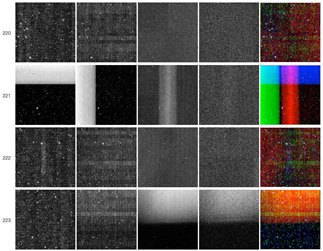 |
| Figure 4 - Single-exposure framesets 03770a220-223. On rare
occasions, large regions of the array show elevated backgrounds, the
cause for which is unknown. The resulting three-color image is
reminiscent of a TV test pattern. Such effects are usually confined to a
single frameset. |
Electronic effects: Dark "test" patterns
 |
| Figure 5 - Single-exposure frameset 03389b235. These
anomalies are similar to the bright "test" patterns seen above except
that the anomalous
areas of the arrays have lower backgrounds than surrounding regions. |
Anneals: Anneal entry
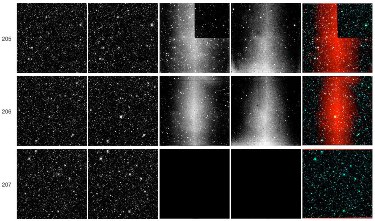 |
| Figure 6 - Single-exposure framesets 01876a205-207. During
the warm-up for an anneal, high and uneven backgrounds will be seen in
W3 and W4. In
this example, elevated and uneven backgrounds are seen in W3 and W4 for
two framesets before levels saturate in both arrays for the third
frameset. |
Anneals: Anneal recovery
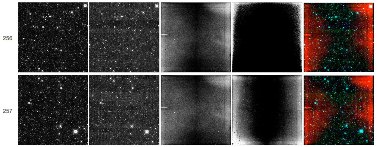 |
| Figure 7 - Single-exposure framesets 01876a256-257. After an
anneal, high and uneven backgrounds will be seen in W3 and W4. In
this example, elevated and uneven backgrounds are seen in W3 and W4 for
two framesets, with levels decreasing between the two. Backgrounds
remain at higher levels for roughly twenty minutes after an anneal, so
many dozens of W3/W4 frames will be impacted. |
Anneals: Anneal-like behavior of unknown origin
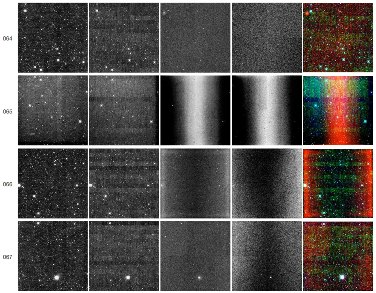 |
| Figure 8 - Single-exposure framesets 01657b064-067. On rare
occasions, the W3 and W4 arrays will exhibit behavior reminiscent of
an anneal, the cause for which is unknown. Here, the second frameset
shows a sudden elevation in counts in the W3 and W4 arrays. The
subsequent two framesets show these higher backgrouds diminishing with
time. |
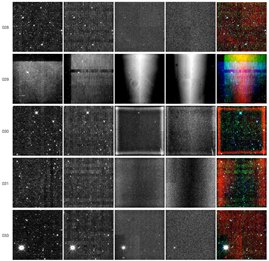 |
| Figure 9 - Single-exposure framesets 02141b028-033. This is
another rare example, which looks like a cross between the anneal-like
behavior
above and the "test" pattern effect noted earlier. |
Streaked frames
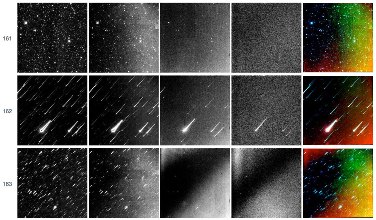 |
| Figure 10 - Single-exposure framesets 03053a161-163. Frames
can become streaked during spacecraft manuevers or when the Moon blinds
one of the
star trackers and attitude control is momentarily compromised. This
example shows an extreme case in which the stars are visibly streaked in
two consecutive framesets. |
Features: Features are imprints caused by real objects but are not real objects themselves. These can be caused by the electronic or optical response of the instruments to bright objects or to the serendipitous observation of earth-orbiting satellites and debris.
Very bright objects: Moon diffraction spikes
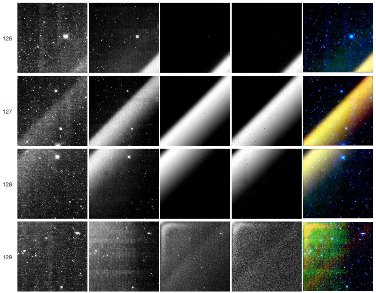 |
| Figure 11 - Single-exposure framesets 01170a126-129. Near first-quarter and last-quarter phases, the Moon falls near the swath of sky
surveyed by WISE. Bright diffraction spikes from the Moon can affect several consecutive framesets, as this example shows. |
Very bright objects: Moon scattered light
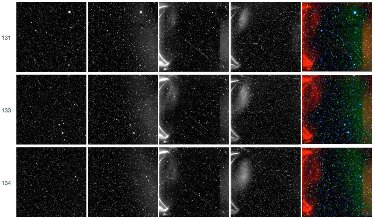 |
| Figure 12 - Single-exposure framesets 01568a131-134.
Scattered light from the Moon near first- and last-quarter takes on a
variety of
forms. In this example, W2 shows diffuse glow whereas W3/W4 show spike-like features and smaller
patches of diffuse light. |
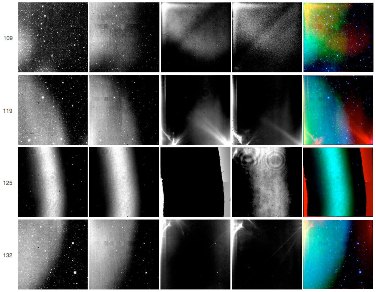 |
| Figure 13 - Single-exposure framesets 03865a109, 119, 125,
and 132. Scattered light from the Moon near first- and last-quarter
takes on a variety of
forms. In this example, all bands are strongly affected with diffuse
glow, sharp features, or both. |
Very bright objects: Latents from bright stars
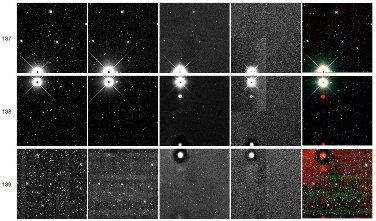 |
| Figure 14 - Single-exposure framesets 03770a137-139. Bright
stars imprint a latent image on all arrays, although the effect is most
prominent at W3 and W4. Here, the bright star in frameset 137 has left a
latent image at the bottom of the subsequent frameset (138),
and because the bright star also falls squarely on this second frameset,
the third (frameset 139) has two latent imprints. In both
cases, this star leaves a latent with a bright core and dark ring. |
Very bright objects: Latents from extended sources
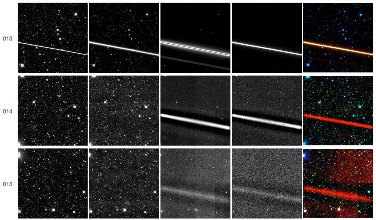 |
| Figure 15 - Single-exposure framesets 03868a013-015. Bright extended sources, such as the satellite trail seen here, will leave latents
with extended shapes. |
Very bright objects: Latents with horizontal jets.
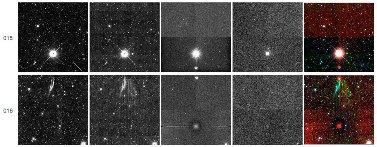 |
| Figure 16 - Single-exposure framesets 02033b015-016.
Infrequently, a bright star will also leave an odd horizontal streak
bisecting the
latent in subsequent frames. In this example, the bright star in
frameset 015 leaves a latent, with horizontal stripe in W3, in frameset
016. |
Very bright objects: Improper correction of long-term latents by dynamic calibration
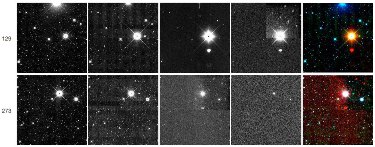 |
| Figure 17 - Single-exposure framesets 07073b129 and 07073b273. The
dynamical calibration that corrects for the effects of long-term latents
isn't perfect, so these artifacts will sometimes be visible in the W3
and W4 images. In this example, long-term latents appear
as light splotches in the drooped quadrant around the bright object in
W4 frame 129 and around the bright star in W3 frame 273. |
Very bright objects: Improper correction of long-term latents by dynamic calibration for pre-anneal frames
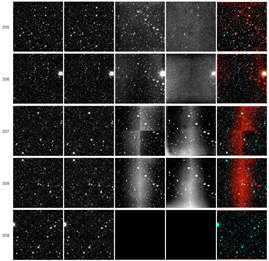 |
| Figure 18 - Single-exposure framesets 02268a205-209. The
dynamical calibration that corrects for the effects of long-term latents
will, at times, not be able to gather sufficient data prior to an anneal
and hence is not able to correct for the persistent images at
W3 and W4. Here, framesets falling before the anneal in frameset 209
show many bright, long-term latents, the most
prominent of which in this example is a heart-shaped latent caused by
the same object viewed on successive orbits. |
Very bright objects: Optical ghosts
 |
| Figure 19 - Single-exposure frameset 01432a010. Bright
objects leave optical ghosts (reflections) in the images. In this
example,
the bright star has created obvious ghosts at W2, W3, and W4. The W2
ghost falls immediately to the right of the bright star (it's
the green object in the three-color image), and the W3 and W4 ghosts fall
below (the W3 ghost showing up as the red blob in the
three-color image). |
Very bright objects: Optical ghosts from a bright planet
 |
| Figure 20 - Single-exposure frameset 03881a129. Extremely bright objects can show multiple ghosts per band. In this example,
the planet Mars shows one/two ghost(s) above it and two below in both the W3 and W4 images. |
Very bright objects: Optical ghosts causing asymmetric PSFs
 |
| Figure 21 - Single-exposure frameset 01321a039. The optical ghosts at W1 falls very close to the bright star itself, causing
what appears to be an asymmetric PSF. In this example. the bright star shows an elongation on the left side of its W1 image,
which is just the W1 ghost distorting the outer contour of the PSF itself. |
Very bright objects: Glint artifacts
 |
| Figure 22 - Single-exposure frameset 01797b053. Bright stars
just off the field of view can leave glints in the frame. In this
example, a bright star leaves dagger-like glints at W3 and W4 and the ghost leaves its own dagger glint in W3. |
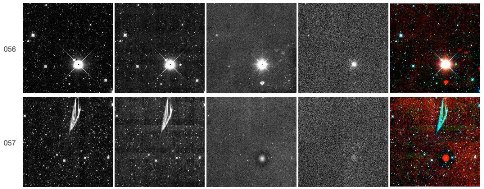 |
| Figure 23 - Single-exposure frameset 02266a056-057. Bright stars just off the field of view can leave glints in the frame.
Here the bright star off the top of the field of view leaves scimitar-shaped glints in W1 and W2. |
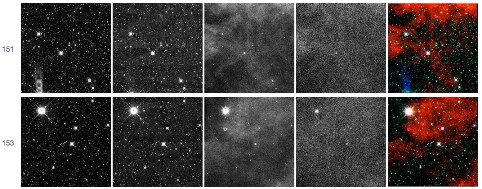 |
| Figure 24 - Single-exposure frameset 01901a151-153. Bright stars just off the field of view can leave glints in the frame.
Here the bright star off the bottom of the field of view leaves a corkscrew-shaped glint in W1. |
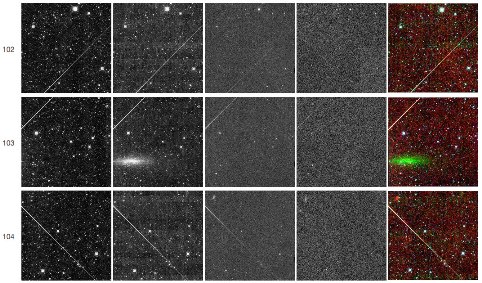 |
| Figure 25 - Single-exposure frameset 01258a102-104. Bright stars just off the field of view can leave glints in the frame.
In this example, the bright star off the left of the field of view leaves a diffuse glint in W2. |
Very bright objects: Glows in W1/W2 from off-frame bright object
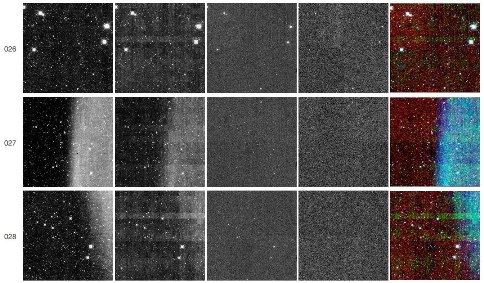 |
| Figure 26a - Single-exposure framesets 01892a026-028. Extremely bright sources just outside the field of view can
create a diffuse glow across the image. In this example, a bright source causes a bright glow that affects roughly
half the array at W1 and W2. |
Very bright objects: Spray of light on the right side of the W1 array
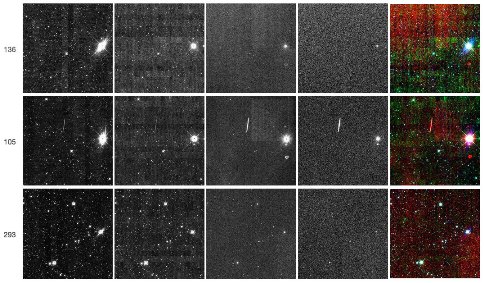 |
| Figure 26b - Single-exposure framesets 04657a136, 01414a105, and 01414a293. Bright stars landing near pixel position (900,530) on the W1 array exhibit a strangely shaped halo. This is a feature of the optics along the right side of the W1 array, the exact cause for which is unknown. |
Very bright objects: NaNs/saturation
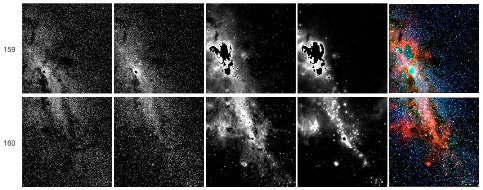 |
| Figure 27 - Single-exposure framesets 02817b159-160. Regions with many saturated pixels (recorded as NaNs, or "Not-a-Number" values)
can create large areas of "missing" data. Here, the Galactic Center saturates many pixels at W3 and W4. |
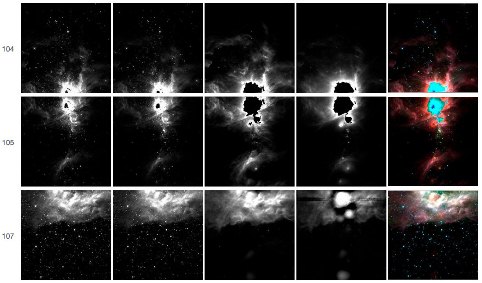 |
| Figure 28 - Single-exposure framesets 02538b104-107. Regions
with many saturated pixels (recorded as NaNs, or "Not-a-Number" values)
can create large areas of "missing" data. Here, the Orion Nebula
saturates many pixels at all four bands. (Note also the extended latents
imprinted in W4 in frameset 107.) |
Radiation hits: SAA passages
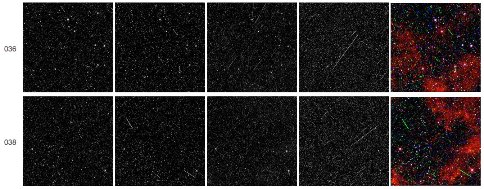 |
| Figure 29 - Single-exposure framesets 03881a036-038. Passages through the South Atlantic Anomaly (SAA) will result in large numbers
of radiation hits in all bands. |
Radiation hits: Massive blasts
 |
| Figure 30 - Single-exposure frameset 02665b037. Some cosmic ray blasts leave an extremely bright, bogus detection in a single band.
In this example, a powerful cosmic ray has impacted the W1 array and left a bleed trail. |
Radiation hits: Cascades
 |
| Figure 31 - Single-exposure frameset 01020a109. Cosmic rays sometimes impact the arrays and leave a shower of bogus detections
in their wake. In this example, a cosmic ray has impacted the W4 array and deposited a long train of false sources. |
Radiation hits: Unusual appearance
 |
| Figure 32 - Single-exposure frameset 03321b034. In rare instances, cosmic rays can create unusual patterns such as
this three-way trail in the upper right quadrant of W4. |
Satellite trails: Bright trails
 |
| Figure 33a - Single-exposure frameset 01170a246. Satellites
in orbit above WISE are frequently seen in the WISE data frames. In this
example, a bright satellite has nearly crossed the entire field of view.
Note that the trail appears longer in W3 and W4 than in W1
and W2 because of the difference in effective integration time between
the two sets of detectors. (Note also that the trail in W3 is
bright enough to cause a ghost trail just below it.) |
 |
| Figure 33b - Single-exposure frameset 03054a047. In this
example, a bright satellite running out of the field of view has created a dagger-like glint in W3/W4 like that seen
by an off-frame, bright star (see Figure 22). |
Satellite trails: Tumblers
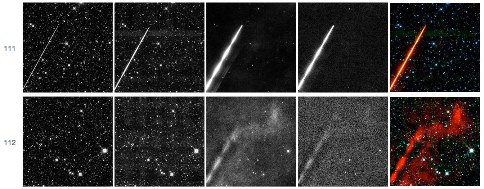 |
| Figure 34 - Single-exposure framesets 02782a111-112. Tumbling
satellites can cause a pulsating streak. In this example, the
satellite is bright enough to have also created both a ghost in the
W3/W4 images of frameset 111 as well as W3/W4 latents in frameset 112. |
Satellite trails: Trails with light and dark portions
 |
| Figure 35 - Single-exposure frameset 01858a073. Some satellite trails may appear "dark" along portions of their trajectories. Here,
the center part of the trail is dark in both W3 and W4. |
Satellite trails: Parallel trails
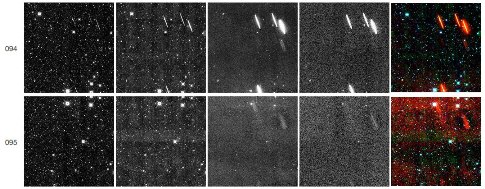 |
| Figure 36 - Single-exposure framesets 02268a094-095.
Satellites frequently appear in groups. In this example, four satellites
are
seen in the same frame. The W3 and W4 images of frameset 094 show ghosts
for the brightest satellite, and frameset 095 shows W3/W4
latents of the streaks, as well. |
Satellite trails: Kinked trails caused by mirror flyback
 |
| Figure 37 - Single-exposure frameset 03069a146. After each
exposure, WISE's scan mirror flips back to its start position so
that it can again compensate for the spacecraft motion and freeze the
next portion of sky onto the arrays. Extremely bright objects
crossing through the field of view during mirror fly-back can thus
leave odd patterns on the array. Here a bright satellite
has left an unusual signature at W3 and W4. |
Satellite trails: Strange effects induced by array readout
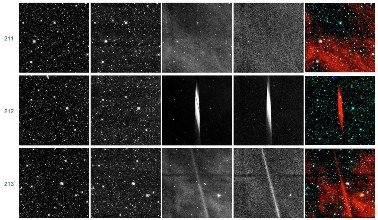 |
| Figure 38 - Single-exposure framesets 01874a211-213. Very
bright satellites crossing the field of view rapidly between exposures
can
leave other odd signatures. In this case, a bright object has moved
through during the readout of frameset 212.
A bright latent of the full trail (not captured in the image sequence)
is seen in the subsequent frameset, along with a dark latent
parallel to array rows. |
Out-of-focus objects near the spacecraft:
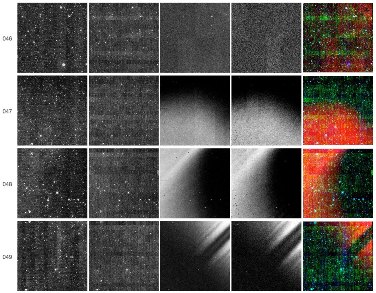 |
| Figure 39 - Single-exposure framesets 01116a046-049. Small
objects relatively near the spacecraft occasionally can pass through the
field
of view and appear as out-of-focus "washers". In this example, a small
object fills most of the W3/W4 frames for three consecutive framesets. |
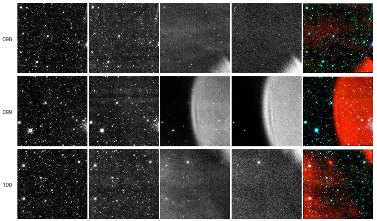 |
| Figure 40 - Single-exposure frameset 02404a098-100. This is another example of a nearby, small object entering WISE's field of view. |
Conspicuous PSF ring around bright sources in W4 (not astrophysical)
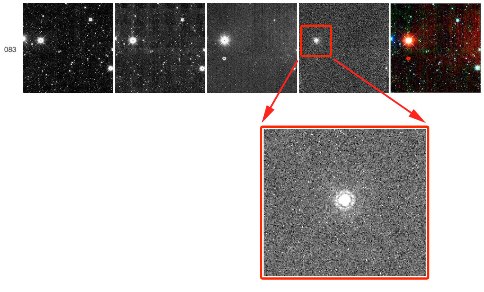 |
| Figure 41 - Single-exposure frameset 02269a083. Bright
sources in W4 exhibit a distinct ring approximately 50 arcsec from their
centroids. This ring is not coincident with either the first (~18
arcsec) or second (~30 arcsec) Airy maxima but is nonetheless assumed to
be a feature of the
extended PSF. |
Astrophysical sources that can look like anomalies: Comet debris trails
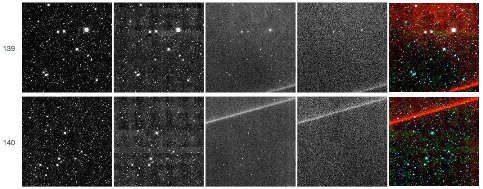 |
| Figure 42 - Single-exposure framesets 03957b139-140. Not all streaks in the images are caused by satellite trails. In this example,
debris along the orbit of a comet leaves a clear signature at W3 and W4. |
 |
| Figure 43 - Single-exposure frameset 03957b162. Not all streaks in the images are caused by satellite trails. In these images,
a comet trail and its parent comet (65P/Gunn) are seen. |
Astrophysical sources that can look like anomalies: Bubbles/shells
 |
| Figure 44a - Single-exposure frameset 01960a048. Not all circular sources are optical ghosts or latents. In this example,
the W4-bright shell of planetary nebula PN G047.0+42.4 is seen. The source is also seen faintly at W3. |
 |
| Figure 44b - Single-exposure frameset 07089b066. Not all circular sources are optical ghosts or latents. In this example,
the W4-bright shell of the Tycho supernova remnant is seen. Part of the shell is also detected at W3. |
Last update: 2012 August 13




















































